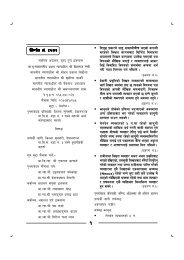The Nepali Judiciary - Supreme Court Of Nepal
The Nepali Judiciary - Supreme Court Of Nepal
The Nepali Judiciary - Supreme Court Of Nepal
Create successful ePaper yourself
Turn your PDF publications into a flip-book with our unique Google optimized e-Paper software.
• With regards to disputes concerning the review of constitutionality of law, the target was to<br />
dispose 100% of the cases in comparison but only 82% of the cases could be disposed<br />
each year, wherein additional responsibility at the rate of 10% per year regarding this issue<br />
has been added.<br />
• With regards to disputes concerning protection of fundamental rights, the target was to<br />
dispose 100% of the cases in comparison wherein disposal has been achieved according<br />
to the target thus causing a decrease in the pending cases by 2.62% per year or in other<br />
words the responsibility has decreased by 71.<br />
• With regards to disputes under the original and appellate jurisdiction, the target of <strong>Supreme</strong><br />
<strong>Court</strong> was to dispose 100% of the cases in comparison to new registration, wherein<br />
disposal has been achieved according to the target thus causing decrease in the<br />
responsibility by an average of 7.80% per year or in other words the responsibility has<br />
decreased by 1,144.<br />
• With regards to disputes under all jurisdictions, the target of <strong>Supreme</strong> <strong>Court</strong> was to dispose<br />
100% of the cases in comparison to new registration, wherein disposal has been achieved<br />
according to the target thus causing decrease in the responsibility by an average of 7.8%<br />
per year or in other words the responsibility has decreased by 1,205.<br />
• Target of Appellate <strong>Court</strong> was to dispose 100% of the cases in comparison to new<br />
registration, wherein disposal has been achieved according to the target thus causing<br />
decrease in the responsibility by an average of0.8% per year or in other words the<br />
responsibility has decreased by 80.<br />
• Target of District <strong>Court</strong> was to dispose 100% of the cases in comparison to new<br />
registration, wherein 95% of the cases has been disposed thereby resulting in addition of<br />
responsibility by 1,669 cases per year.<br />
• Target of other courts and tribunals were to dispose 100% of the cases in comparison to<br />
new registration, wherein 82% of the cases has been disposed thereby resulting in addition<br />
of responsibility by 231 cases per year.<br />
• Target of all courts and tribunals were to dispose 100% of the cases in comparison to new<br />
registration, wherein 99% of the cases has been disposed thereby resulting in addition of<br />
responsibility by 618 cases per year.<br />
• If we are to look into the overall disposal rate of all courts and tribunals, although the courts<br />
and tribunals are competent to dispose the number cases in comparison to new<br />
registration, they have failed to dispose the cases within the prescribed limitation i.e. within<br />
a period of one year.<br />
• From the overall data, we can conclude that it is not a problem for our courts and judges<br />
and employees to address the problem of work load, problem lies in reducing the quantity<br />
i.e. capacity to address within the prescribed period.<br />
3.2.1.4 Execution of Decision<br />
<strong>The</strong> Plan had envisaged to dispose petitions regarding execution of decisions within 6 months and<br />
provided the same could not achieved, the Plan had envisaged that disposal of such petitions<br />
would not exceed one year. Likewise, the Plan had envisaged and targeted to decrease the<br />
pending petitions by 75% at the rate of 15% per year. Overall data regarding execution of decision<br />
during the Plan period is provided herein below:<br />
21




![lg0f{o g+=&(&# g]=sf=k= @)^% ;af]{Rr cbfnt ljz]if Ohnf; ;DdfggLo k ...](https://img.yumpu.com/10045627/1/190x245/lg0fo-g-gsfk-afrr-cbfnt-ljzif-ohnf-ddfgglo-k-.jpg?quality=85)
![lg0f{o g+=&(@% g]=sf=k= @)^% ;jf]{Rr cbfnt, ljz]if Ohnf; dfggLo ...](https://img.yumpu.com/6479513/1/190x245/lg0fo-g-gsfk-jfrr-cbfnt-ljzif-ohnf-dfgglo-.jpg?quality=85)

![lgj]b s ljkIfL - Supreme Court Of Nepal](https://img.yumpu.com/5482729/1/190x245/lgjb-s-ljkifl-supreme-court-of-nepal.jpg?quality=85)